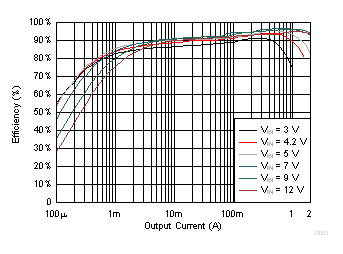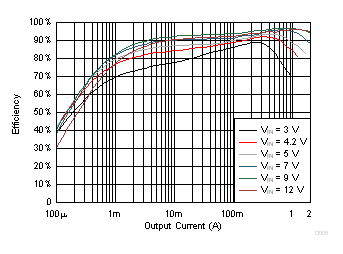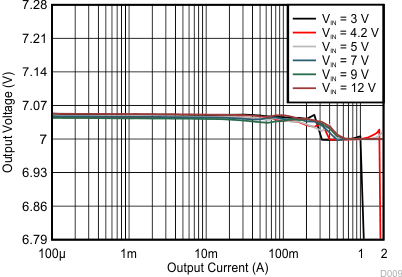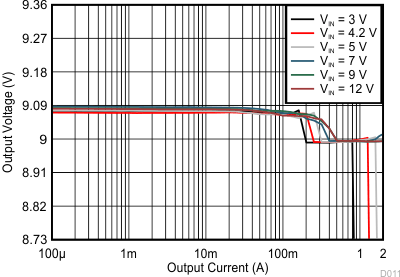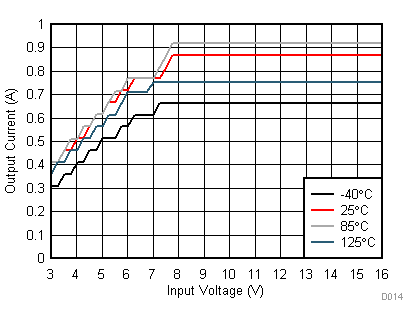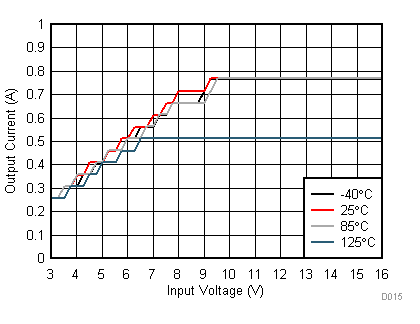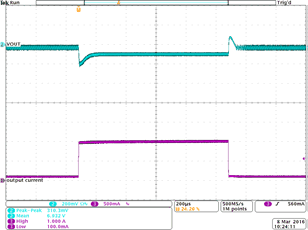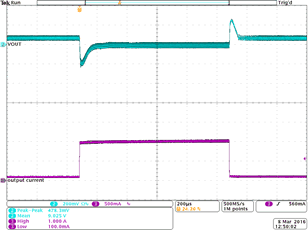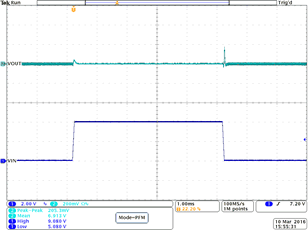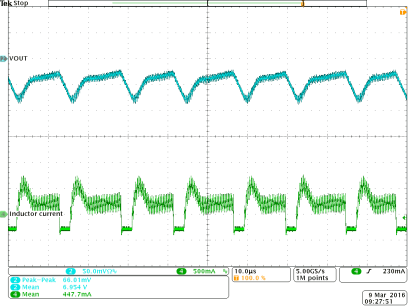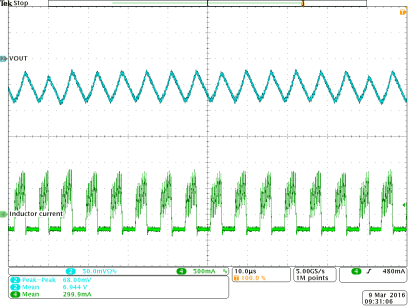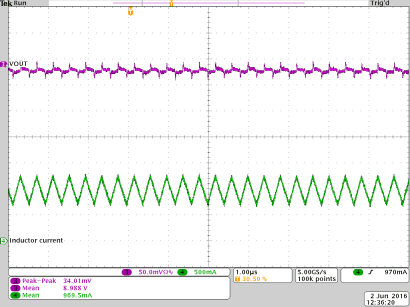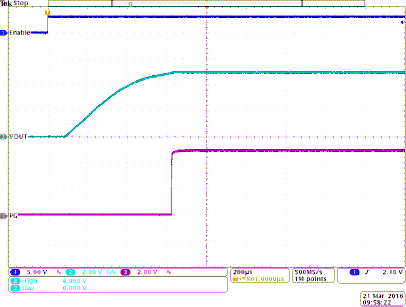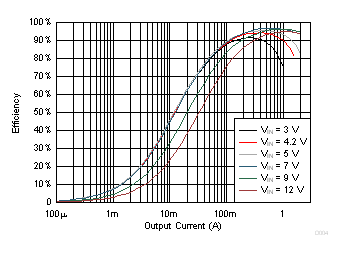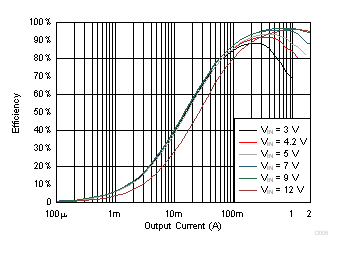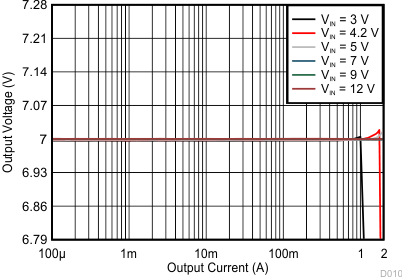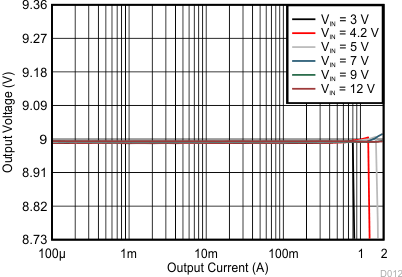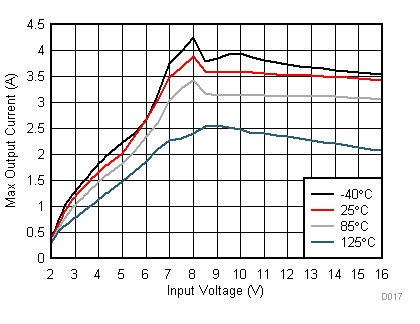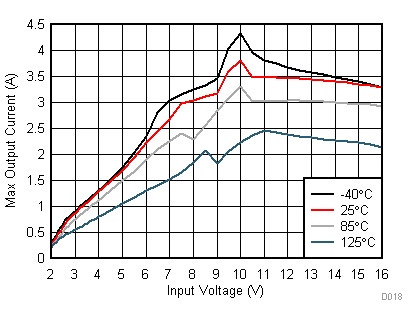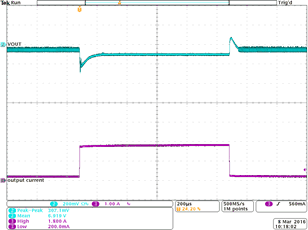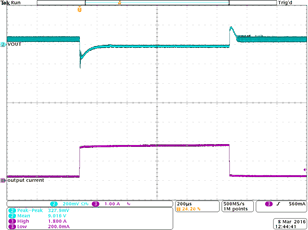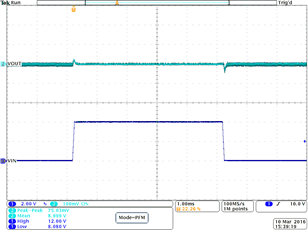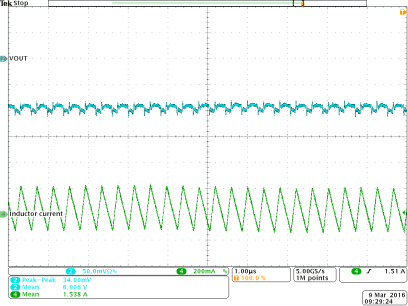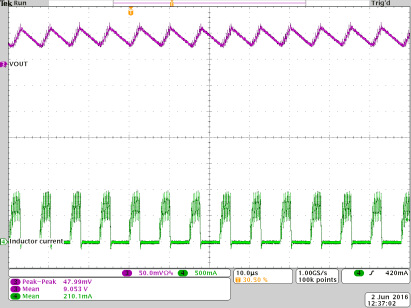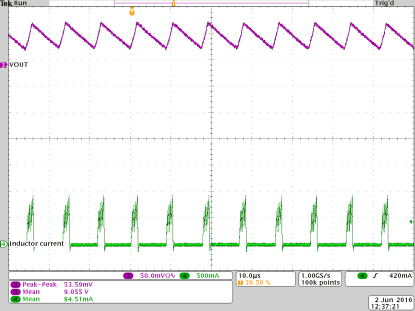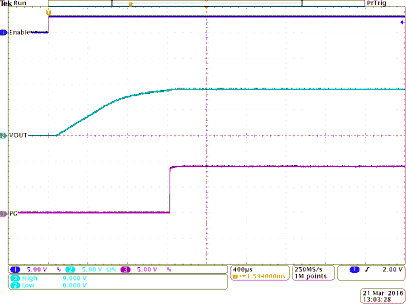| Efficiency |
| Efficiency vs Output Current (PFM/PWM) |
VIN = 3 V, 4.2 V, 5 V, 7 V, 9 V, 12 V, VOUT = 7 V , PS/SYNC = Low |
Figure 11 |
| Efficiency vs Output Current (PWM only) |
VIN = 3 V, 4.2 V, 5 V, 7 V, 9 V, 12 V, VOUT = 7 V , PS/SYNC = High |
Figure 12 |
| Efficiency vs Output Current (PFM/PWM) |
VIN = 3 V, 4.2 V, 5 V, 7 V, 9 V, 12 V, VOUT = 9 V , PS/SYNC = Low |
Figure 13 |
| Efficiency vs Output Current (PWM only) |
VIN = 3 V, 4.2 V, 5 V, 7 V, 9 V, 12 V, VOUT = 9 V , PS/SYNC = High |
Figure 14 |
| Load Regulation |
| Load Regulation, PFM/PWM Operation |
VIN = 3 V, 4.2 V, 5 V, 7 V, 9 V, 12 V, VOUT = 7 V , PS/SYNC = Low |
Figure 15 |
| Load Regulation, PWM Operation |
VIN = 3 V, 4.2 V, 5 V, 7 V, 9 V, 12 V, VOUT = 7 V , PS/SYNC = High |
Figure 16 |
| Load Regulation, PFM/PWM Operation |
VIN = 3 V, 4.2 V, 5 V, 7 V, 9 V, 12 V, VOUT = 9 V , PS/SYNC = Low |
Figure 17 |
| Load Regulation, PWM Operation |
VIN = 3 V, 4.2 V, 5 V, 7 V, 9 V, 12 V, VOUT = 9 V , PS/SYNC = High |
Figure 18 |
| Output Current |
| Typical Start-up Current vs Input Voltage |
VOUT = 7 V, TJ = -40 °C, 25 °C, 85 °C, 125 °C |
Figure 19 |
| Maximum Load Current vs Input Voltage |
VOUT = 7 V, TJ = -40 °C, 25 °C, 85 °C, 125 °C, PG = high |
Figure 20 |
| Typical Start-up Current vs Input Voltage |
VOUT = 9 V, TJ = -40 °C, 25 °C, 85 °C, 125 °C |
Figure 21 |
| Maximum Load Current vs Input Voltage |
VOUT = 9V, TJ = -40 °C, 25 °C, 85 °C, 125 °C, PG = high |
Figure 22 |
| Regulation Accuracy |
| Load Transient, PFM/PWM Boost Operation |
VIN = 4.2 V, VOUT = 7 V, Load = 100 mA to 1 A, PS/SYNC = Low |
Figure 23 |
| Load Transient, PFM/PWM Buck Operation |
VIN = 12 V, VOUT = 7 V, Load = 200 mA to 1.8 A, PS/SYNC = Low |
Figure 24 |
| Load Transient, PFM/PWM Boost Operation |
VIN = 4.2 V, VOUT = 9 V, Load = 100 mA to 1 A, PS/SYNC = Low |
Figure 25 |
| Load Transient, PFM/PWM Buck Operation |
VIN = 12 V, VOUT = 9 V, Load = 200 mA to 1.8 A, PS/SYNC = Low |
Figure 26 |
| Line Transient, PFM/PWM Operation |
VIN = 5 V to 9 V, VOUT = 7 V, Load = 1 A, PS/SYNC = Low |
Figure 27 |
| Line Transient, PFM/PWM Operation |
VIN = 8 V to 12 V, VOUT = 9 V, Load = 1 A, PS/SYNC = Low |
Figure 28 |
| Output Voltage Ripple |
| Output Voltage Ripple, PFM/PWM Operation |
VIN = 5 V, VOUT = 7 V, Load = 0.3 A, PS/SYNC = Low |
Figure 29 |
| Output Voltage Ripple, PWM Operation |
VIN = 5 V, VOUT = 7 V, Load = 1 A, PS/SYNC = high |
Figure 30 |
| Output Voltage Ripple, PFM/PWM Operation |
VIN = 12 V, VOUT = 7 V, Load = 0.3 A, PS/SYNC = Low |
Figure 31 |
| Output Voltage Ripple, PFM/PWM Operation |
VIN = 5 V, VOUT = 9 V, Load = 0.1 A, PS/SYNC = Low |
Figure 32 |
| Output Voltage Ripple, PWM Operation |
VIN = 5 V, VOUT = 9 V, Load = 0.5 A, PS/SYNC = high |
Figure 33 |
| Output Voltage Ripple, PFM/PWM Operation |
VIN = 12 V, VOUT = 9 V, Load = 0.1 A, PS/SYNC = Low |
Figure 34 |
| Startup |
| Start-up Behavior from Rising Enable, PFM/PWM Operation |
VIN = 4.5 V, VOUT = 7 V, Load = 0.5 A, PS/SYNC = Low |
Figure 35 |
| Start-up Behavior from Rising Enable, PFM/PWM Operation |
VIN = 7 V, VOUT = 9 V, Load = 0.5 A, PS/SYNC = Low |
Figure 36 |
